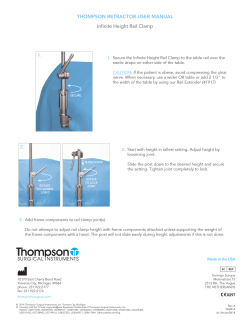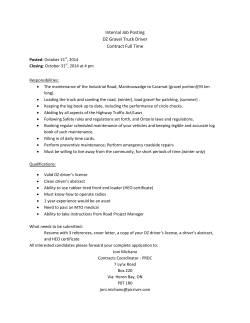
Taking the Guesswork out of Clamp Force Control
Taking the Guesswork out of Clamp Force Control Sponsored by: Presented by: Craig Gillam Pat McKernan © 2015 MHI® Copyright claimed for audiovisual works and sound recordings of seminar sessions. All rights reserved. Taking the Guesswork out of Clamp Force Control BACKGROUND The material handling industry moves millions of unitized boxed loads and white goods loads in a steady stream from factory, to warehouse and onto the final destination. One of the most efficient means for moving large volumes of unitized loads is with carton clamps, an attachment that handles product without pallets. The challenge of clamp force • A wide spectrum of loads with different packaging types, box integrity, load size and weight • Each load requires an optimal amount of clamp force to prevent over clamping or under clamping the load. Taking the Guesswork out of Clamp Force Control GUESSWORK: A HIDDEN CAUSE OF PRODUCT DAMAGE A System of Symbols • An international set of symbols exists to communicate carton handling guidelines. • The Clamping Symbol indicates where to clamp, and sometimes how much force to use. (e.g., “Max 1700 lbf.”) • If a force setting is specified, the driver must either – use a fully automated system or – guess at how much force is needed to comply. • If not specified, driver must – remember the proper amount of clamp force from experience or – guess at the amount of force to use. Clamp Force Guesswork • Guesswork: when the amount of clamp force that should be applied to a load – is not known – cannot be controlled – or when driver’s clamp force decision is influenced by a variety of other factors Driver Concerns • Driving safely • Following local process requirements • Recording product location and quantity • Determining where to take the load • Correctly loading the trailer • Interfacing with Warehouse Management System • Moving loads quickly and efficiently • Crushing or dropping the load Driver Guesswork Appropriate pressure selection, knowing the correct pressure value: • for every particular load type • for every particular load configuration • for every particular packaging type • Confidence that the correct pressure value has been selected before clamping Taking the Guesswork out of Clamp Force Control HISTORICAL PERSPECTIVE 1975: Levers-and-buttons interactivity • The lucky drivers today are faced with properly setting the required amount of clamp force using 40-year-old mechanical technology. 2015: Touchscreen Technology • Drivers might be more inclined to interact with an intelligent, modern device rather than 40-year-old mechanical technology. Taking the Guesswork out of Clamp Force Control METHODS & DEVICES TO CONTROL PRESSURE AND FORCE Three Methods to Control Pressure and Force • Driver Managed • Mechanical 3-Position Pressure Regulator • Electronic 3-Position Pressure Regulator Driver Managed Concept: Use no regulator at all and let the driver guess by “feathering” the auxiliary handle. Advantages • No added cost. Compromises • Rarely successful • Always inconsistent • Most likely to cause product damage • Highest job stress on drivers because it requires guesswork and results in worry. Mechanical 3-Position Pressure Regulator Concept: Allows the driver to change the auxiliary pressure by moving a mechanical lever, with three pressure relief settings (low, medium & high) Advantages • Simple • Low cost Compromises • Not within easy reach • May not include a ‘position’ for every load • Drivers tend to keep the position on highest force • Easy to get confused on the proper position for a high variety of load types, encouraging guesswork Electronic 3 or 4-Position Pressure Regulator Concept: Improving on the simpler mechanical version, the electronic 3 or 4-setting switch is positioned within easy reach of the driver. Advantages • Simple high, medium & low settings • Ergonomic placement encourages driver use Compromises • May not include a ‘position’ for every load • Drivers tend to keep the position on highest force • Easy to get confused on the proper position for a high variety of load types, encouraging guesswork. Pressure Regulators vs. Driver Tendencies The success of methods of force control using pressure regulators are dependent on the unlikely acceptance of the individual driver who understands that: • Dropping the load = job loss • Any setting less than the highest MAY mean the risk of dropping the load • Crushing a product is often not detectable until much later, hard to trace and therefore not a job loss concern. • The increase in task speed (reward) and fear of job loss (punishment) combine to discourage using pressure regulators in the manner in which they were intended. Taking the Guesswork out of Clamp Force Control SOLUTIONS OF A HIGHER ORDER Remove driver guesswork from the equation with customer-specified clamp forces for each load. Automatic clamp force selection based-solutions: • Load Configuration (weight) Recognition – Assumes correct clamp force is proportional to the load weight. • Volumetric Force Control – Assumes correct clamp force is proportional to the load volume. • Interactive, Visual Force Control – Touchscreen interactive Interactive, Visual Force Control Concept: Touch-screen technology bridges the gap between mechanical methods and technically advanced systems. It allows the driver to consistently select and use the proper clamp force for a wide variety of load types, configurations and packaging styles. Advantages • Easy—requires no driver guesswork or memory • A few quick touches set the correct clamp force • Minimal training time • Not limited to just 3 or 4 clamp force settings Conclusion Product damage as a result of driver guesswork can be virtually eliminated by using newly available control technologies to specify accurate clamp force across the wide range of load configurations and types. For More Information: craig.gillam@cascorp.com pat.mckernan@cascorp.com Website: www.cascorp.com Or visit ProMat 2015 Booth 4149
© Copyright 2025









